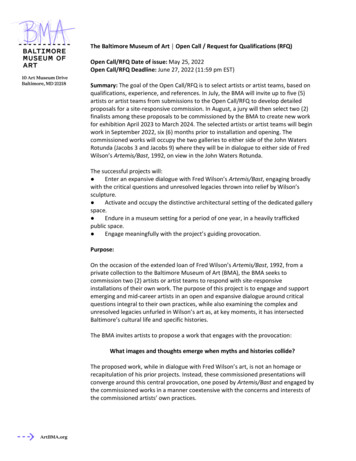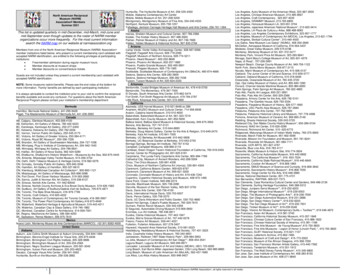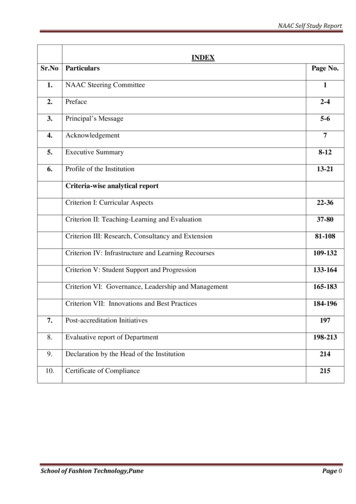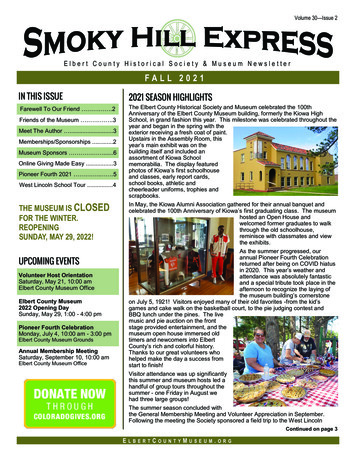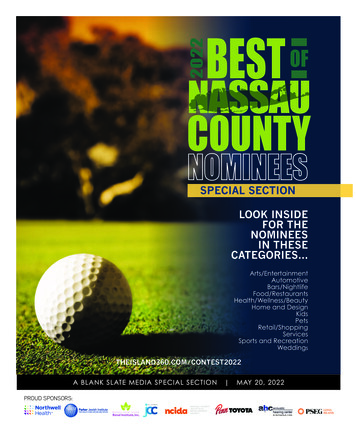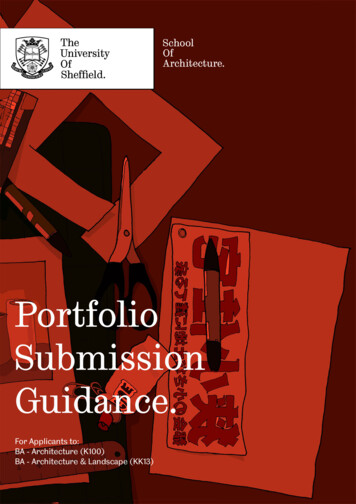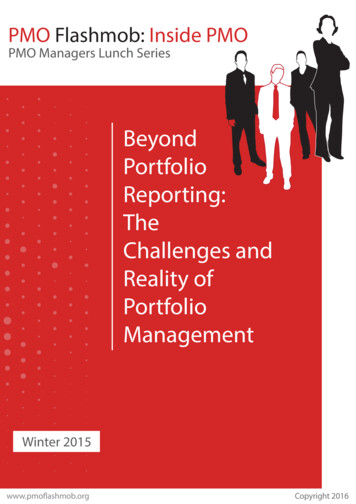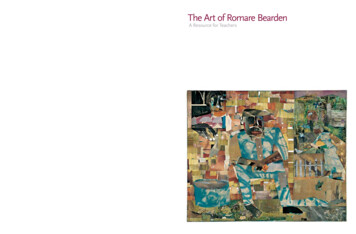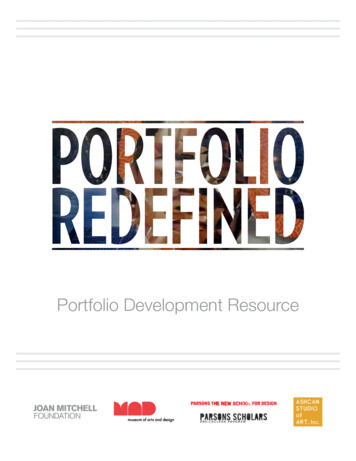
Transcription
Portfolio Development Resource
POR T F OL IO DEVEL OPM EN T R E S O U R C EContentsAbout Portfolio Redefined . . . . . . . . . . . . . . . . . . . . . . . . 1Portfolio Development . . . . . . . . . . . . . . . . . . . . . . . . . . . 2Portfolio Tips . . . . . . . . . . . . . . . . . . . . . . . . . . . . . . . 3Artist Statement . . . . . . . . . . . . . . . . . . . . . . . . . . . . . 12Writing For Your Portfolio . . . . . . . . . . . . . . . . . . . . . . . . 12Digital Portfolio Strategies . . . . . . . . . . . . . . . . . . . . . . . . 13High School Portfolio Examples . . . . . . . . . . . . . . . . . . . . . 16Student Spotlight . . . . . . . . . . . . . . . . . . . . . . . . . . . . 26Content Contributors . . . . . . . . . . . . . . . . . . . . . . . . . . . 29 3
POR T F OL IO DEVEL OPM EN T R E S O U R C EAbout Portfolio RedefinedPortfolio Redefined is for all aspiring students who arepreparing an art and design portfolio for college admission, aswell at art teachers facilitating this process.Parsons, Museum of Arts and Design, the Joan MitchellFoundation and Ashcan Studio of Art host portfoliodevelopment and college access events throughout theyear. We are devoted to workshopping ideas and practicesto support students in building a competitive portfolio andapplication for art & design college programs. Throughout theyear, separate workshops are hosted for students, parents,and educators.PORTFOLIO REDEFINED 2014-2015 CALENDAROctober 11, 2014Portfolio Redefined Art Degree Demystified at Frank SinatraHigh SchoolJanuary 10, 2015Senior Art School Application Check-in at Museum of Arts &DesignMarch 7, 2015Careers in the Arts Fair at ParsonsJune 18, 2015Portfolio Redefined: Educators Edition/Scholastic/AdmissionsSummit at ParsonsJuly 27–31, 2015Portfolio Bootcamp at Joan Mitchell Foundation Education &Research Center, Museum of Arts & Design, and Parson 1
POR T F OL IO DEVEL OPM EN T R E S O U R C EPortfolio DevelopmentCREATING A PORTFOLIOPORTFOLIO REVIEW DAYAll colleges have different admissions requirements andspecific portfolio formats. Be sure to familiarize yourself witheach school’s requirements before applying.Each year art schools send representatives to variouslocations to review students’ portfolios and providefeedback. This is a great way for students to getan assessment of their work before applying. Therepresentatives who come to these events are normallyprofessors and people from admissions.Colleges require between 8-25 slides/images. They may askfor slides in a sheet, a carousel, or a CD-ROM of images (notusually original pieces).For Fine Art portfolios (paintings, drawings, and sculptures),schools require a range of work that includes observationaldrawings and (depending on one’s intended major)3-dimensional objects. At least half of a traditional artportfolio must include art made from direct observation. Anapplicant’s portfolio should be a range of personal work, notjust work from classroom assignments.Including older pieces can demonstrate growth in thestudent’s work, however admissions officers normally wantto see an applicant’s most recent art. It is recommendedfor students to develop more pieces than the admissionsportfolio requires. This way students can choose the bestwork that represents them.The days and locations that this event are being held in NewYork are the following:Saturday, November 15, 2014Purchase, New YorkSUNY Purchase: School of Art and Design12:00pm–4:00pmSunday, November 16, 2014New York, New YorkJacob K. Javits Convention Center12:00pm–4:00pmPersonal artwork should be based around a theme and isreflective of the student’s interest and identity. If there is anart style that the artist is heavily influenced by such as anime,they should include drawings of their own original subjectmatter rather than drawing licensed characters. Studentsshould also avoid drawing subject matter like skulls (unless itis part of a still life), hearts, eyes (by themselves), and copiedimages from pre-existing artwork. This kind of imageryshould be avoided because these subject matter are oftenoverUsing different mediums can evidence the artist’s range anddifferentiate each of the pieces. Also finding ways to visuallydepict experiences relevant to the student’s intended majorcan be an effective strategy for strengthening one’s portfolio.A student should always use a sketchbook to plan theirpieces as well as develop other ideas or practice their craft.SOURCE: ArtSchools.com, Financial Aid for Art Students, 1997,www.artschools.com/financial-aid/ 2
POR T F OL IO DEVEL OPM EN T R E S O U R C EPORTFOLIO TIP #1BE OBSERVATIONALDraw, paint and sculpt what you see, with emotion and sensibility.LIFE PORTRAIT EXAMPLES»» a family member»» your hands or feet»» a friend»» a self-portrait»» yourself»» nude figure drawings»» someone sleepingSTILL LIFE DRAWING EXAMPLES»» collect a group of random objects»» a combination of some of your favorite objects»» contents of your bag»» objects within a certain color range or subject matterJOEUN, ASHCAN STUDENT – ACCEPTED TO NYU, FINE ARTKEREN, ASHCAN STUDENT – ACCEPTED TO CORNELL, FINE ART 3
POR T F OL IO DEVEL OPM EN T R E S O U R C EJINYOUNG, ASHCAN STUDENT – ACCEPTEDTO CORNELL, FINE ARTJASON, ASHCAN STUDENT – ACCEPTEDTO PARSONS, FASHION DESIGN SIMOON, ASHCAN STUDENT – ACCEPTEDTO SVA, ILLUSTRATIONELANOR, ASHCAN STUDENT –ACCEPTED TO SVA, ILLUSTRATION4
POR T F OL IO DEVEL OPM EN T R E S O U R C EPORTFOLIO TIP #2THEMATICChose an overall theme--something that interests you--and base yourportfolio work on this theme. Some work can address the theme directly,some abstractly.THEMATIC EXAMPLES»» sleep»» money»» dreaming»» identity»» ecology»» nostalgia»» urban life»» opposites»» compassion»» mirrors»» family»» pattern»» hybrids»» powerJOSEPH, ASHCAN STUDENT – ACCEPTEDTO COOPER UNION, FINE ART 5
POR T F OL IO DEVEL OPM EN T R E S O U R C EPORTFOLIO TIP #3BE YOURSELFMake work for your portfolio that reflects who you are. Be genuine andexpress your true identity. Work that is honest has the most impact.YOU AS AN ARTIST/DESIGNER:»» Where do you come from?»» How did your upbringing shape you?»» What do you remember most vividly?»» What are your likes and dislikes?»» Whatever it was that first inspiredyou to draw, build on that inspiration,and keep building.SIMOON, ASHCAN STUDENT – ACCEPTED TO SVA, ILLUSTRATION 6
POR T F OL IO DEVEL OPM EN T R E S O U R C EPORTFOLIO TIP #4USE DIFFERENT MEDIUMSMedium refers to the art materials or artist supplies used to create a workof art. It is whatever you use to make a mark upon a surface. Tools for artmaking are all around you.MEDIUMS TO TRY:»» pen»» water»» plastic»» food/candy»» marker»» charcoal»» newspaper»» a book»» crayon»» paper»» receipts»» metal»» paint»» wood»» trash»» clayELEANOR, ASHCAN STUDENT – ACCEPTED TO SVA, ILLUSTRATION YOORO, ASHCAN STUDENT – ACCEPTEDTO PARSONS, FASHION DESIGN7
POR T F OL IO DEVEL OPM EN T R E S O U R C ETING TING, ASHCAN STUDENT – ACCEPTED TO RISD, FINE ARTKEREN, ASHCAN STUDENT – ACCEPTED TO CORNELL, FINE ARTJIN SOO, ASHCAN STUDENT – ACCEPTED TO PARSONS, FASHION DESIGN 8
POR T F OL IO DEVEL OPM EN T R E S O U R C EPORTFOLIO TIP #5USE A SKETCHBOOKCarry it around with you each day. The drawings you make here, and thenotes that you take, are golden insights into what you are attracted to as anartist/ designer. Sketchbooks provide a place for you to identity and visuallynarrate what you see and imagine. Remember to take a look at what you’vedrawn and written about in the past; it will inspire you.SKETCHBOOK IDEAS:»» Record popular culture and your opinion of it.»» Scrutinize and record the body language of thepopulation around you: the shape of a crowd,the expression on someone’s face, the waya hand holds a newspaper, an umbrella, or acoffee.»» Draw automatically: let your pencil or penwander across the paper and see where it takesyou.»» Cut out textures, images or poetry and add it toyour sketchbook.»» Leave them as they are or incorporate them intosketches.»» Think about each entire page of your sketchbookas its own universe, narrative, or composition.JIYEON, ASHCAN STUDENT – ACCEPTED TO RISD, INDUSTRIAL DESIGN 9
POR T F OL IO DEVEL OPM EN T R E S O U R C EPORTFOLIO TIP #6SHOW YOUR DEDICATION TO ART MAKINGChallenge yourself and maintain a positive attitude. Schools receive thousandsof portfolios; if your work looks like you cared about it and enjoyed making it,it will show dedication and commitment to learning.WAYS TO SHOW YOUR DEDICATION:»» Branch out: include music, film, clothing, etc. that youhave made in your portfolio.»» Know that art never stops being challenging.»» Make every drawing/painting/sculpture/mixed mediawork you do better than the last.»» If another artist’s work inspires you, try to do what thatartist did with whatever means you have.JIHYE, ASHCAN STUDENT – ACCEPTED TOPARSONS, GRAPHIC DESIGN»» If you strive for something big, you will surprise yourself.TING TING, ASHCAN STUDENT – ACCEPTED TO RISD, FINE ART JINYOUNG, ASHCAN STUDENT – ACCEPTED TO SVA, ILLUSTRATIONJEE HEE, ASHCAN STUDENT – ACCEPTED TO SVA, FINE ART10
POR T F OL IO DEVEL OPM EN T R E S O U R C EPORTFOLIO TIP #7DOCUMENT RELEVANT EXPERIENCESExplore ways to visualize related experiences. If you’re interested inarchitecture and have experience helping your dad do construction work, howcan you represent that work visually? If you’re interested in art education andhave taught arts & crafts at summer camp, how can you share that work?Consider photos, videos, digital media, a graphic novel, etc.THIS ARTIST USED AUDIO TO DESCRIBE HER WORK:“The footprint I created represents my mom and the journey she has taken in her life.” 11
POR T F OL IO DEVEL OPM EN T R E S O U R C EArtist StatementAn artist statement is a personal essay that informs collegeswho the student is, what they are interested in, their artisticprocess, and what type of work they make. Art schoolsusually include a specific question for students to answer thatis related to the art they make and communicates what makesthem an ideal candidate for admission.PERSONAL TOPICS THAT STUDENTSOFTEN HAVE TO WRITE ABOUT ARE:»» “Who am I?”»» ”Where am I coming from?”»» “Where do I hope to go?”The student’s answer should be a humble, honest responsethat is explained in-depth. Using common intros such as“I always knew I wanted to be an artist” can give weakenthe impact of the student’s statement. The choice of wordsin a statement should be comfortable within the student’svocabulary.EXAMPLES OF WHAT SOME ART SCHOOLS ASKSTUDENTS TO RESPOND TO INCLUDE:»» “What do you make, how do you make it, and whydo you make? Ultimately, where do you visualize yourcreative abilities and academic study to take you afteryour education here at Parsons? (Maximum 500 words)”(Parsons)»» “Describe when and how you became interested in art,design, writing, architecture, or the particular major towhich you are applying. Describe how this interest hasmanifested itself in your daily life” (Pratt)»» “What makes you a perfect candidate for FIT? Why areyou interest in the major you are applying to? The essayis also a chance to tell us more about your experiences,activities and accomplishments.” (FIT)SOURCE: The Museum of Arts and Design, Portfolio Redefined, folio-redefinedWriting For Your PortfolioADVICE FROM CAROLINA WHEAT,DIRECTOR OF ADMISSIONS FOR PARSONSIn your statement or essay:1.Represent yourself through text.2.Use words you are comfortable using.3.Discuss your process.4.Please do not begin the essay “I always knew I wanted tobe an artist.” 12
POR T F OL IO DEVEL OPM EN T R E S O U R C EDigital Portfolio StrategiesCapturing the work you have done- static, time based, visualwritten.“Quality of documentation affectsperceived quality of work”- CYNTHIA LAWSONDOCUMENTING A PORTFOLIO:To be able to submit your portfolio you need to have yourwork documented, which means either photographed orscanned. In most cases photographing your artwork will bethe ideal solution (large scanners aren’t always available tostudents and they can’t document 3d work), so here are somepointers for documenting your portfolio this way.The camera used to photograph the artwork is less importantthan how it’s used.TIPS FROM CYNTHIA LAWSONARTIST AND ACADEMIC THE NEW SCHOOLThe images should be clear and straightforward and not shotat an angle. The piece should be oriented at the vertical andhorizontal center of the picture plane.Documentation is not just images:it is Image Video Sound TextPieces should be shot on a neutral background (ex: cleanwhite wall, paper backdrop) or on site if it’s within context.Documentation is not just final work:it is Final Work ProcessSOURCE: oredefined-workshop-documentation-writing Never use flash when photographing artwork. Pieces shouldeither be shot using two point studio lighting or naturaldaylight. The lighting should be even and not dominate partsof the artwork.Files for online use should be saved at 72 dpi either as a .jpegor .gif. Files for print should be saved at minimum of 150 dpieither as a .tiff, .png, or .PSD. File names should correspondwith application requirements. Two folders should be madefor storing the images, one for the student and one forsubmission.13
POR T F OL IO DEVEL OPM EN T R E S O U R C EDOCUMENTATION EXAMPLESCAMERA: It is not the camera you use, but how youuse it.ANGLE: Take photographs of your work straight on(centered both vertical and horizontal), be careful notto angle the camera above, below or from the side.USING DIRECT CAMERA ANGLESphotographed from abovephotographed from belowphotographed from centerSASKIA, JOAN MITCHELLFOUNDATION PARTICIPANTphotographed from right photographed from left14
POR T F OL IO DEVEL OPM EN T R E S O U R C ECONTEXTTake photographs of your work in front of a neutralbackground (backdrop paper), or in some cases, on site.LIGHTING»» Never use a flash, they can create “hot spots” in theimage, and produce harsh and uneven lighting.PHOTOGRAPHED ON SITE. JOEUN, ASHCANSTUDENT – ACCEPTED TO NYU, FINE ART»» Use two point (evenly lit) studio lightingor natural light (sunlight)ILLUSTRATION OF TWOPOINT LIGHTING SET UPFILE MANAGEMENT“HOT SPOT” FROM USING FLASH»» Digital files for screen display use should be saved at 72dpi as jpeg files.»» Files for printing should be saved at a minimum 150 dpi,(preferably 300 dpi) .tiff, .png, or .psd at print size»» Keep both versions in separate folders, and save theoriginal files at full size as a back up.»» Appropriately name files and folders: be sure to includeyour name in the file or folder name in the versions yousubmit to the school.»» When saving your files don’t use spaces: useunderscores (example: Figuredrawing Lawson.jpeg )IMAGE SIZE SETTINGS IN PHOTOSHOP»» 2-D work, list Dimensions x Height x Width –measurements in inches»» 3-D work, list Dimensions x Height x Width –measurements in inchesFILES:FOLDERS:»» Keep your statement and reflective text in folders withdocumentationNAMING FILES AND FOLDERS 15
POR T F OL IO DEVEL OPM EN T R E S O U R C EHigh School Portfolio ExamplesThis section contains portfolios of students who have been accepted into art school. The purpose of showing these is to notonly demonstrate what art schools are looking for but also to provide emphasis on the importance of having a diverse yetcohesive body of work. Each portfolio here integrates both traditional and conceptual subject matter and also presents theinterests of the artists themselves. A high school portfolio should not only be a demonstration of a student’s technical abilitybut their ability to come up with new interesting ideas and solutions to problems.PORTFOLIO #1: CrystalJOAN MITCHELL FOUNDATIONART EDUCATION PROGRAM PARTICIPANTAttended: Jacqueline Kennedy Onassis High SchoolJoan Mitchell Foundation Saturday Studio ClassesApplied to: Pratt Institute, Parsons The New School forDesignAttending: Parsons The New School for DesignPORTFOLIO TIPS FROM CRYSTAL»» Manage time efficiently»» Have your work reviewed but be confident in yourdecisions»» Be cohesive about your ideas and how you executethem.»» Put your strongest pieces in. Quality over quantity. 16
POR T F OL IO DEVEL OPM EN T R E S O U R C E 17
POR T F OL IO DEVEL OPM EN T R E S O U R C EPORTFOLIO #2:LobsangJOAN MITCHELL FOUNDATIONART EDUCATION PROGRAM PARTICIPANTAttended: Newtown High SchoolApplied To: Fashion Institute of Technology, LaGuardiaCommunity College, Queensborough Community College.Attending: Fashion Institute of TechnologyPORTFOLIO TIPS FROM LOBSANGParticipating in art programs is helpful for strengtheningyour skills and expanding your portfolio.Keep updating your portfolio and resume.Work on your life drawings because most schools requireat least 3 of them.When documenting sculptures for submission, it is wise totouch-up the background in Photoshop.If you’re more comfortable speaking in person about yourwork schedule an appointment for a portfolio review withadmissions. 18
POR T F OL IO DEVEL OPM EN T R E S O U R C E 19
POR T F OL IO DEVEL OPM EN T R E S O U R C EPORTFOLIO #3: VickyJOAN MITCHELL FOUNDATIONART EDUCATION PROGRAM PARTICIPANTAttended: Fontbonne Hall AcademyApplied To: Cooper Union, School of Visual ArtsAttending: School of Visual Arts (majoring in computer art)PORTFOLIO TIPS FROM VICKY»» Experiment and work out of your comfort zone.»» Use feedback from critiques to improve your work.»» Give yourself only a certain amount of time to work onone piece, and move on.»» Always keep a camera or a sketchbook on you!»» Set a goals for yourself that are related to finalizingyour portfolio(ex: getting 5 life drawings done in amonth). 20
POR T F OL IO DEVEL OPM EN T R E S O U R C E 21
POR T F OL IO DEVEL OPM EN T R E S O U R C EPORTFOLIO #4: MatthewJOAN MITCHELL FOUNDATIONART EDUCATION PROGRAM PARTICIPANTAttended: Williamsburg Charter High SchoolApplied To: Pratt Institute, School of Visual Arts,Fashion Institute of Technology, Cooper Union Schoolof Art, New York University Tisch School of the ArtsAttending: Pratt Institute 22
POR T F OL IO DEVEL OPM EN T R E S O U R C EPORTFOLIO #5: JosephJOAN MITCHELL FOUNDATIONART EDUCATION PROGRAM PARTICIPANTAttended: Renaissance Leadership AcademyApplied To: Pratt Institute, College of StatenIsland, New York City College of Technology,Fashion Institute of TechnologyAttending: Fashion Institute of Technology(majoring in toy design) 23
POR T F OL IO DEVEL OPM EN T R E S O U R C EPORTFOLIO #6: MeganJOAN MITCHELL FOUNDATIONART EDUCATION PROGRAM PARTICIPANTAttended: Notre Dame High SchoolApplied To: Pratt Institute, Hunter College, St.Johns University, The College of New RochelleAttending: The College of New Rochelle 24
POR T F OL IO DEVEL OPM EN T R E S O U R C E 25
POR T F OL IO DEVEL OPM EN T R E S O U R C EStudent SpotlightAKINYEMI’S PRE-COLLEGE PORTFOLIOAkinyemiJOAN MITCHELL FOUNDATION ART EDUCATION PROGRAM PARTICIPANTAND ASHCAN STUDIO OF ART SCHOLARSHIP RECIPIENTSTUDENT INTERVIEW:Interviewer (I): How did you set aside time to work on yourportfolio?Akinyemi (A): While at the Ashcan Studio of Art, I devoted most ofmy time to building my portfolio. I would go to class from 11am to8pm at night. and sometimes I even stayed till around 2 am.I: Did you receive any outside help (extracurricular activities orportfolio intensives) while developing your portfolio?A: I started off as a student in the Young Adult Program at the JoanMitchell Foundation. After being in the program, I was advised byJosé Ortiz to apply for the scholarship at the Ashcan Studio of Art,where I developed my college portfolio.I: What did you have in mind when making pieces for your portfolio?A: Most of the time when making pieces for my portfolio my mindsetwas on creating a finished piece that could be presentable to thecolleges I was applying to in person, and not just digital. I believecreating or recognizing a finished piece can be a tough task,considering that I have never really taken any art class that enforcesthat.I: What was your planning phase like?A: My planning phase involved a lot of research and looking intocurrent affairs, because I like when my works speak on what isgoing on our society.I: How did you go about documenting your work?A: While I was at the Ashcan Studio my works were photographedand documented by professionals.I: What were some of the challenges you’ve faced when working onyour portfolio?A: One of the most challenges I faced was doing 3-D works. It waschallenging because it was out of my comfort zone.I: What advice would you give to students who are going to or arecurrently working on their portfolios?A: My advice to students who are working on their portfolio is toresearch the schools/major they are applying to, so that they can build works that best fit.26
POR T F OL IO DEVEL OPM EN T R E S O U R C EAKINYEMI’S PRE-COLLEGE PORTFOLIO 27
POR T F OL IO DEVEL OPM EN T R E S O U R C EAKINYEMI’S PRE-COLLEGE PORTFOLIO 28
POR T F OL IO DEVEL OPM EN T R E S O U R C EContent ContributorsASHCAN STUDIO OF ARTwww.ashcanstudio.comAshcan Studio of Art is an art school geared toward creativedevelopment and portfolio preparation. Our curriculum is anindividualized program in which each student’s personal interests andskills are the focus. With a lot of hard work, and with the resources ofNew York City’s arts community, 100% of our students have excelledto their greatest potential and have earned admittance into many ofthe highest-ranked BFA and MFA programs, most having receivedscholarships.At Ashcan, we believe that artistic growth and development shouldtake place in a diverse and supportive environment. Our studentscome from around the region and from around the world to studyat our studios in midtown Manhattan and Queens. Our instructorsare professionals in the visual arts with a passion for teaching. Theyoffer a breadth and depth of knowledge and experience in Drawing,Painting, Sculpture, Illustration, Animation, Theater Design, IndustrialDesign, Computer & Graphic Design, Fashion Design, Interior Designand Architectural Design.JOAN MITCHELL FOUNDATIONwww.joanmitchellfoundation.orgA central principle of the Foundation’s mission is to encouragethe ambitions and education of developing visual artists. TheFoundation’s Art Education program strives to fulfill this missionby providing opportunities for both emerging youth artists andworking adult artists through inclusive and diverse arts educationprogramming, offered completely free to the public.The program enhances the artistic education of young painters andsculptors through studio classes, in concert with other educationalopportunities encouraging students to pursue and develop theirvoice in the arts. Simultaneously, the program supports the artisticdevelopment of working painters and sculptors through teachingopportunities, professional development training, and engagementwith the artistic community.The Art Education program began in 1997 with a single communitypartner, four Artist-Teachers and two classes that servedapproximately thirty students on Saturdays. Currently, the ArtEducation program partners with six organizations, offers Saturday,weekday, and summer programming, employs over forty ArtistTeachers, and serves 1,000 students each week.MUSEUM OF ART AND DESIGNwww.madmuseum.orgof making and the creative processes by which materials aretransformed, from traditional techniques to cutting-edge technologies.Today, the Museum’s curatorial program builds upon a rich historyof exhibitions that emphasize a cross-disciplinary approach toart and design, and reveals the workmanship behind the objectsand environments that shape our everyday lives. MAD providesan international platform for practitioners who are influencing thedirection of cultural production and driving 21st-century innovation,fostering a participatory setting for visitors to have direct encounterswith skilled making and compelling works of art and design.PARSONS THE NEW SCHOOL FOR DESIGNwww.newschool.edu/parsonsThere are many ways to pursue a Parsons education. We arecommitted to educating the next generation of design professionals,artists, critics and scholars. As a result, we are dedicated to the ideathat the academic structure of our school should be flexible, and theacademic instruction should be rigorous and offer both depth andbreadth of disciplinary expertise. Balancing disciplinary expertise andcross-disciplinary capacity in a world that is increasing demandingboth is our goal.PARSONS PRE COLLEGE myParsons Pre-College Academy courses promote design thinking,creativity, and collaboration. Designed for students in grades 3through 12, Pre-College Academy classes meet Saturday morningsduring the school year and for two weeks during the summer. Classesare organized by grade level for elementary school, middle school,and high school groups. Academy courses include animation,fashion, graphic design, interior design, drawing, painting, cartooning,photography, and portfolio developmentPARSONS SCHOLARSwww.scholars.parsons.eduThe Parsons Scholars Program is a three-year college accessprogram in art and design for highly motivated NYC public highschool students. Beginning in 10th grade, Parsons Scholars dedicatethree years of Saturdays and summers to art and design studioclasses while exploring careers and learning how to be successfulin art & design college programs. Students build college and careerreadiness skills and to learn how to make well-informed decisionsaround college admissions, financial aid and areas of study. Thisneed-based scholarship covers the cost of all pre-college classes, artsupplies and travel for accepted 10th graders.The Museum of Arts and Design (MAD) champions contemporarymakers across creative fields, presenting artists, designers, andartisans who apply the highest level of ingenuity and skill to theirwork. Since the Museum’s founding in 1956 by philanthropist andvisionary Aileen Osborn Webb, MAD has celebrated all facets 29
About Portfolio Redefined Portfolio Redefined is for all aspiring students who are preparing an art and design portfolio for college admission, as well at art teachers facilitating this process. Parsons, Museum of Arts and Design, the Joan Mitchell Foundation and Ashcan Studio of Art host portfolio
